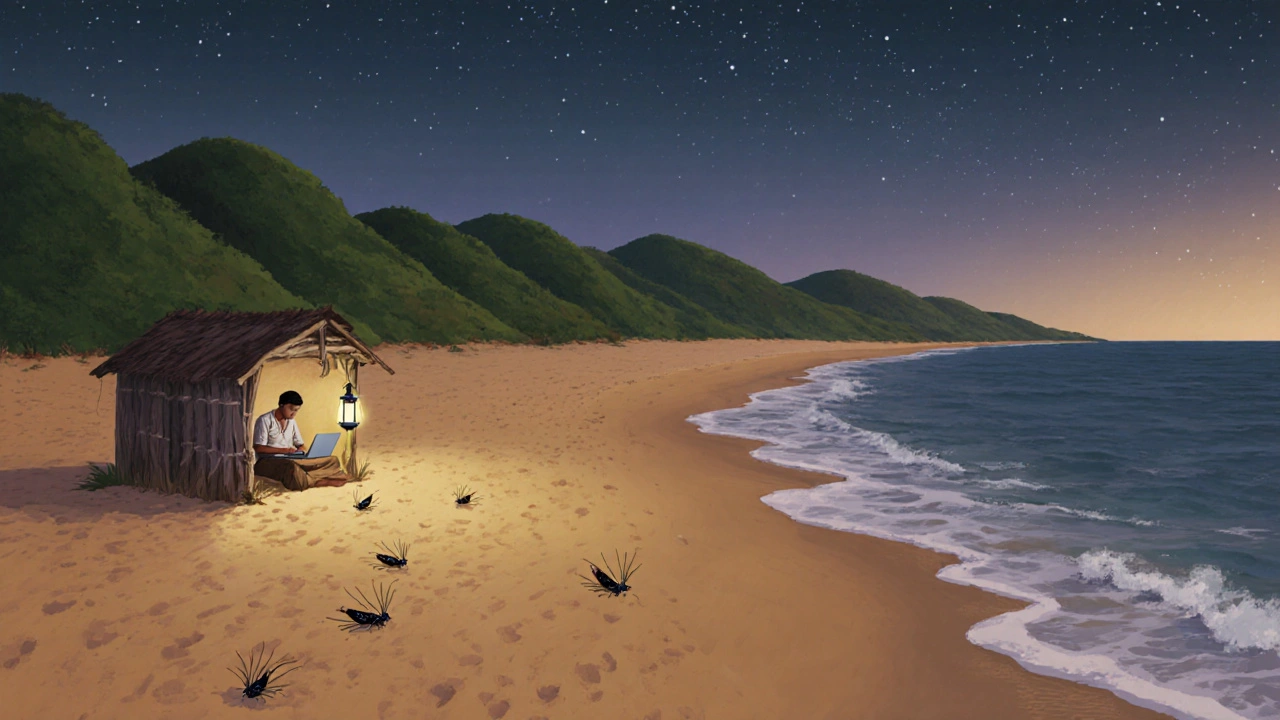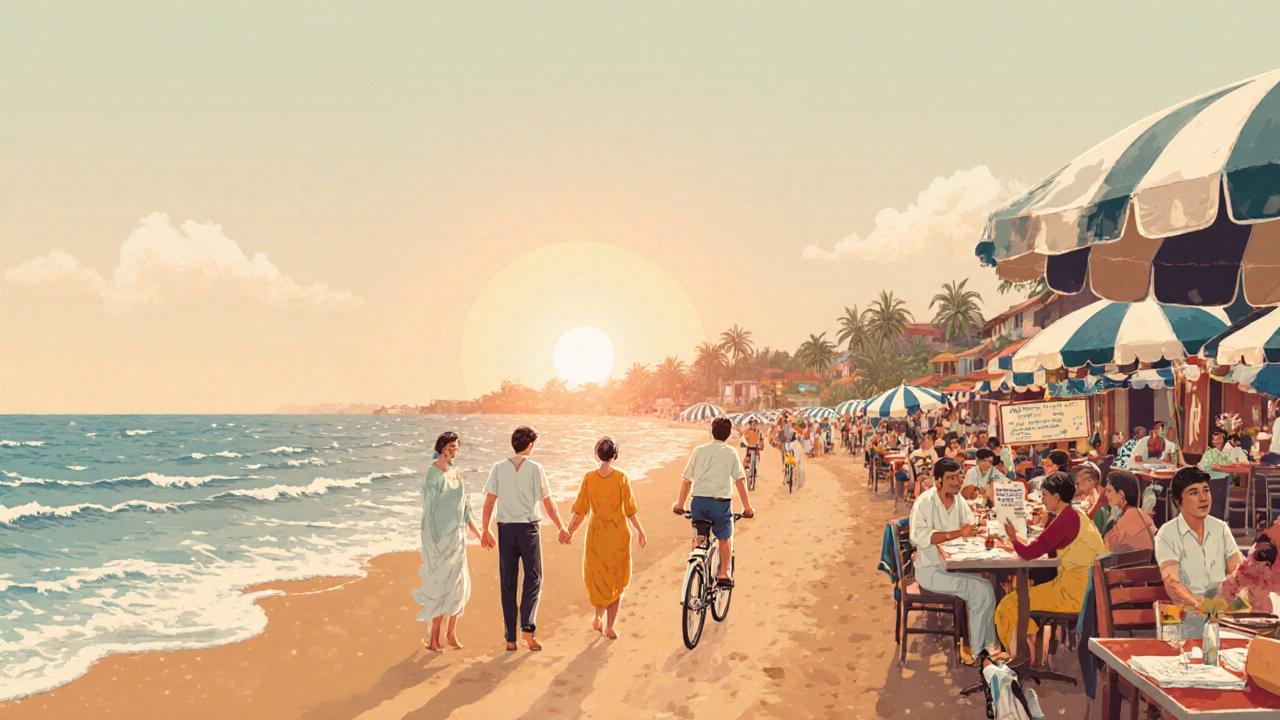Goa Beach Preference Calculator
What Matters Most to You?
Why this beach matches you
Goa’s beaches aren’t just sand and sea-they’re where the world comes to unwind. Every year, over 2 million foreign visitors land here, and not all of them end up at Baga or Calangute. While those spots are loud, crowded, and packed with party-goers, the real favorites among travelers from Europe, Australia, and North America are quieter, slower, and more soulful. So which beaches do foreigners actually prefer? It’s not about the biggest or the brightest. It’s about the vibe.
Palolem: The Quiet Escape That Feels Like a Secret
Palolem Beach, tucked into South Goa’s crescent-shaped bay, is the beach most foreign travelers whisper about. It’s not on every Instagram feed, but it’s on every backpacker’s itinerary. Why? Because it feels like a village that accidentally became a beach. Wooden shacks line the shore, not high-rise hotels. The water is calm enough for swimming, and the sunset views? Unmatched. You’ll find Germans reading books under palm trees, Israelis doing yoga at dawn, and Brits sipping coconut water while watching fishing boats return. There’s no loud music. No jet skis. Just the sound of waves and the occasional call of a seagull.
Foreigners come back to Palolem year after year-not because it’s fancy, but because it’s real. The beach is clean, the locals are warm, and the beachside shacks serve fresh seafood for under ₹500. Many rent simple cottages for weeks, treating it like a temporary home. It’s the kind of place where you don’t need to plan much. You just show up, and the rhythm of the place takes over.
Agonda: For Those Who Want to Disappear
If Palolem feels like a peaceful village, Agonda feels like a hidden chapter in a novel. It’s a 1.5-kilometer stretch of golden sand, backed by green hills and dotted with just a handful of guesthouses. No traffic lights. No shops selling fake sunglasses. No vendors chasing you down the beach. That’s exactly why travelers from Scandinavia, Canada, and the UK flock here.
Agonda is the go-to spot for digital nomads, yoga retreats, and people who need to unplug. Many foreign visitors stay for months, working remotely from beachside cafés that serve oat milk lattes and avocado toast. The beach is long enough that you can walk for an hour without seeing another person. At night, the only lights come from lanterns strung above the shacks. You’ll hear more crickets than car horns.
It’s not for everyone. If you need nightlife, ATMs, or Uber, this isn’t your beach. But if you want silence, starry skies, and the feeling that you’ve found a place the world forgot, Agonda delivers.
Colva: The Middle Ground with Charm
Colva Beach is often overlooked by travel blogs, but it’s quietly popular with foreign families and older travelers. Unlike the rowdy crowds of North Goa, Colva keeps things relaxed. The beach is wide, the sand is soft, and the water is shallow enough for kids to play safely. You’ll see French couples walking hand-in-hand at sunset, Dutch retirees reading novels under umbrellas, and American families renting bicycles to explore nearby villages.
Colva has more amenities than Palolem or Agonda-pharmacies, grocery stores, and even a few English-language bookshops-but it doesn’t feel commercialized. The restaurants serve authentic Goan curries, not generic pasta. The beach is patrolled by local police, so it feels safe. And the guesthouses? Many are family-run, with balconies overlooking the sea and homemade banana pancakes for breakfast.
It’s not the most Instagrammable beach in Goa, but it’s one of the most lived-in. Foreigners who stay here often say they wish they’d found it sooner.

Why These Beaches? The Real Reasons Foreigners Choose Them
It’s not just about the sand or the water. Foreigners pick these beaches because they match what they’re looking for after a long flight:
- Peace over noise-No EDM festivals, no blaring speakers, no pushy touts.
- Authenticity over polish-They want to see local life, not a tourist replica.
- Slowness over speed-Time moves differently here. Meals take 45 minutes. Wi-Fi is slow. That’s the point.
- Safety and cleanliness-Foreigners notice when the beach is picked up daily, when the toilets are clean, and when locals treat them with respect.
North Goa beaches like Baga and Anjuna still draw crowds, but mostly from younger travelers looking for parties. The foreign visitors who come back year after year? They’re the ones who choose quiet. They’re the ones who don’t want to be entertained-they want to rest.
What Foreigners Say About Goa’s Best Beaches
Travel forums are full of stories. One British woman wrote: “I came to Goa for a week. I stayed for six months. Palolem didn’t feel like a vacation. It felt like coming home.” A German couple shared: “We’ve been to Thailand, Bali, and the Maldives. Goa is the only place where we didn’t feel like tourists. We felt like guests.”
Another common theme: food. Foreigners rave about the Goan fish curry, the fresh bread from local bakeries, and the mangoes that taste like sunshine. They don’t eat at fancy restaurants. They eat where the locals do-at small stalls with plastic chairs and handwritten menus.
They also notice the difference in service. In many places, staff smile because they’re trained to. In Goa, they smile because they’re happy. That’s hard to fake.

When to Go? Timing Matters
The best time to visit these beaches is between November and February. The weather is dry, the humidity drops, and the sea is calm. That’s when most foreign visitors arrive. If you go in July or August, you’ll find rain, closed shacks, and fewer people-foreign or local.
March and April are warm but still good, especially if you want to avoid the peak crowds. By May, the heat starts to climb, and by June, the monsoon hits hard. Plan your trip around the cool months if you want the full experience.
What to Pack for These Beaches
Forget the designer swimsuits and five pairs of shoes. Foreigners who love Goa’s quiet beaches pack light:
- Light cotton clothes-breathable, easy to wash
- A good book or two
- Reusable water bottle-plastic is banned on many beaches
- Small flashlight or headlamp-power cuts happen
- Basic first-aid kit-pharmacies are far in some areas
- Sunscreen-Goa’s sun is strong, even in winter
You won’t need a power bank. Most shacks have solar charging. You won’t need fancy gear. Just a towel, a hat, and patience.
Final Thought: It’s Not About the Beach. It’s About the Feeling.
Foreigners don’t choose Palolem, Agonda, or Colva because they’re the most beautiful. They choose them because they’re the most human. These beaches don’t scream for attention. They don’t offer fireworks or VIP lounges. They offer stillness. They offer connection. They offer a chance to breathe.
If you’re looking for the beach foreigners return to, don’t follow the crowds. Walk away from the loud music. Turn down the road that looks less polished. Find the shack with the handwritten sign and the owner who remembers your name. That’s where you’ll find the real Goa.
Which beach in Goa is safest for foreign tourists?
Palolem, Agonda, and Colva are consistently rated as the safest beaches for foreign tourists. They have low crime rates, regular beach patrols, and clean facilities. Unlike North Goa’s party zones, these beaches have fewer incidents of theft or harassment. Local authorities prioritize safety here because tourism is a major income source, and word-of-mouth matters.
Are these beaches crowded with foreigners in peak season?
Yes, but not in a way that ruins the experience. Between November and February, you’ll see more foreign faces, especially in Palolem and Colva. But because these beaches are long and spread out, you can always find a quiet spot. Agonda remains relatively uncrowded even at peak times. Unlike Baga, where you might feel packed in, here you can still have your own patch of sand.
Can I stay long-term on these beaches?
Absolutely. Many foreigners rent monthly or even yearly accommodations in Palolem and Agonda. Guesthouses offer discounted rates for long stays, and some even provide Wi-Fi, laundry, and kitchen access. You’ll find expats from Germany, Sweden, and Canada living here for months, working remotely or simply taking a break from their home countries. The visa rules for tourists allow stays up to 180 days, which is enough for most.
Do these beaches have good internet for remote work?
Most guesthouses and cafés in Palolem and Colva now offer reliable Wi-Fi, especially since the rise of digital nomadism. Speeds vary, but 10-20 Mbps is common. Agonda has spottier connectivity, but many remote workers choose it for the peace-even if they need to work from the main road a few hundred meters away. For serious work, bring a backup hotspot or use a local SIM card with Jio or Airtel.
Is it expensive to visit these beaches as a foreigner?
No. While prices have risen slightly in the last few years, these beaches remain affordable. A basic beach shack room costs ₹1,200-₹2,500 per night. Meals at local shacks are ₹200-₹400. A taxi from the airport to Palolem is under ₹1,500. Compared to Bali or Phuket, Goa is still one of the cheapest beach destinations in Asia for quality and comfort. You don’t need to spend much to feel like you’ve arrived.
